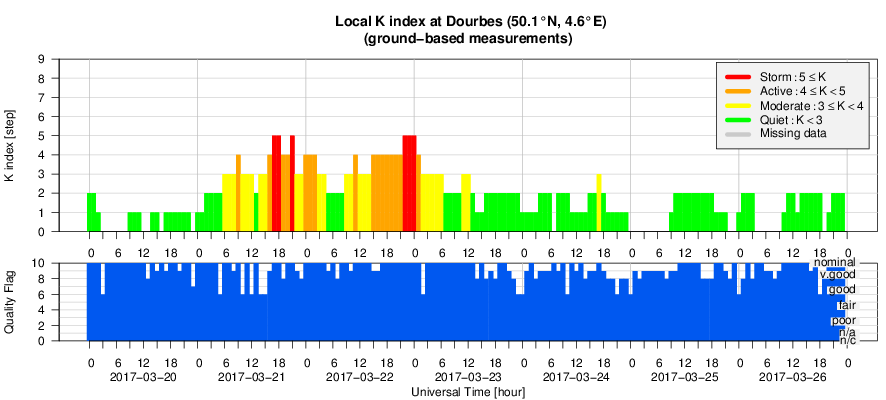- Table of Content
- 1.C-class flares...
- 2.Sponsor and Ex...
- 3.PROBA2 Observa...
- 4.Review of sola...
- 5.The Internatio...
- 6.Geomagnetic Ob...
- 7.Review of iono...
- 8.Future Events
2. Sponsor and Exhibition packages at ESWW14
3. PROBA2 Observations (20 Mar 2017 - 26 Mar 2017)
4. Review of solar activity
5. The International Sunspot Number
6. Geomagnetic Observations at Dourbes (20 Mar 2017 - 26 Mar 2017)
7. Review of ionospheric activity (20 Mar 2017 - 26 Mar 2017)
8. Future Events
C-class flares at last!
Late on 26 March, the GOES-15 satellite recorded its first C-class flare in more than a month (24 February). The source region was developing sunspot group NOAA 2644, which evolved into a mature group over the subsequent days. Meanwhile, another small but compact group was emerging near the southeast solar limb. NOAA 2645 quickly took the lead in being the most flare productive region, producing a C5 flare on 27 March, the strongest event since 21 January this year. The SDO images underneath show both regions at the time of the C5 flare in white light (left) and in extreme ultraviolet (right; AIA131).
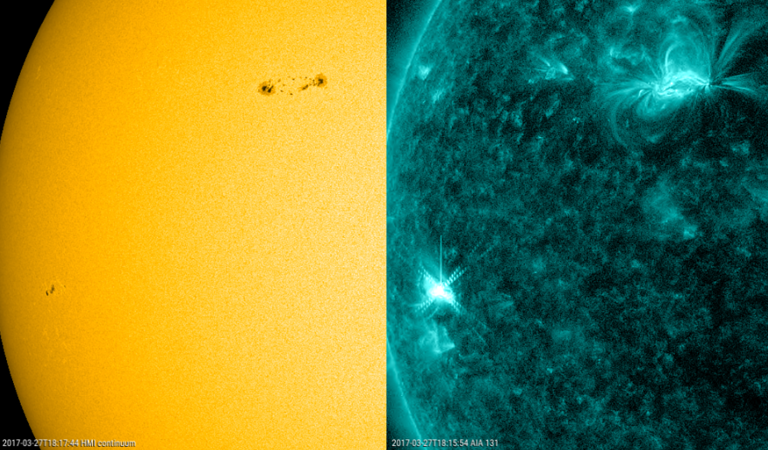
As already indicated, the latest series of C-class flares marks a sudden upswing in solar activity. In fact, these are the first solar flares for this month (March 2017). The very low activity can be seen in the GOES-15 x-ray measurements underneath, with even B-class flares absent for 2 weeks. The daily dips in the x-ray curves are eclipses of the GOES satellite by the Earth.
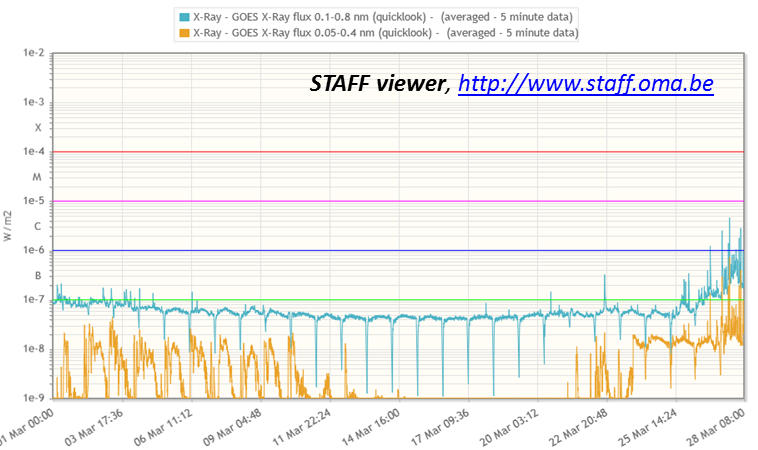
Since the latest solar cycle maximum, solar activity has been gradually waning. This can be seen in the graph underneath, depicting the daily number of C-, M- and X-class flares (Common, Medium and eXtreme flares). A general decrease can be seen in the number and intensity of the solar flares. The last X-class flare dates back already from 5 May 2015, and the last M-class flare from 29 November 2016. Also, the average waiting time between flares has also steadily been growing. In 2015, daily C-class flares were the norm, with M-class flares regularly occurring. Since September 2016, we only had 2 (two) M-class flares and about 50 C-class flares. Worst of all, with the upcoming solar cycle minimum, the situation is unlikely to improve. Solar observers will have to live from an occasional resurgence of sunspot and flaring activity, similar to the ongoing episode. Wouldn't it be great we can report next week on an M-class flare?...
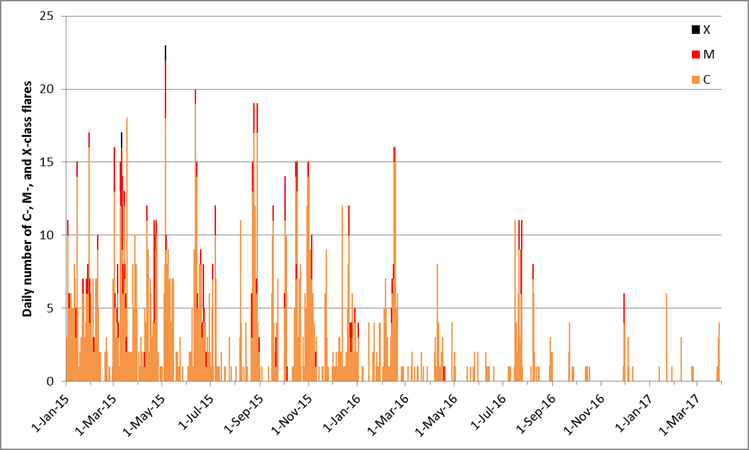
Sponsor and Exhibition packages at ESWW14
If you want to brand your company or institute at ESWW14, we can help you. We have a nice variety of sponsor and exhibition packages: diamond, golden, silver and basic. Pick your favourite colour!

Check the website: http://www.stce.be/esww14/sponsor.php
PROBA2 Observations (20 Mar 2017 - 26 Mar 2017)
Solar Activity
Solar flare activity remained very low during the week.
In order to view the activity of this week in more detail, we suggest to go to the following website from which all the daily (normal and difference) movies can be accessed: http://proba2.oma.be/ssa
This page also lists the recorded flaring events.
A weekly overview movie can be found here (SWAP week 365):
http://proba2.oma.be/swap/data/mpg/movies/weekly_movies/weekly_movie_2017_03_20.mp4
Details about some of this week's events, can be found further below.
If any of the linked movies are unavailable they can be found in the P2SC movie repository here:
http://proba2.oma.be/swap/data/mpg/movies/
Wednesday Mar 22
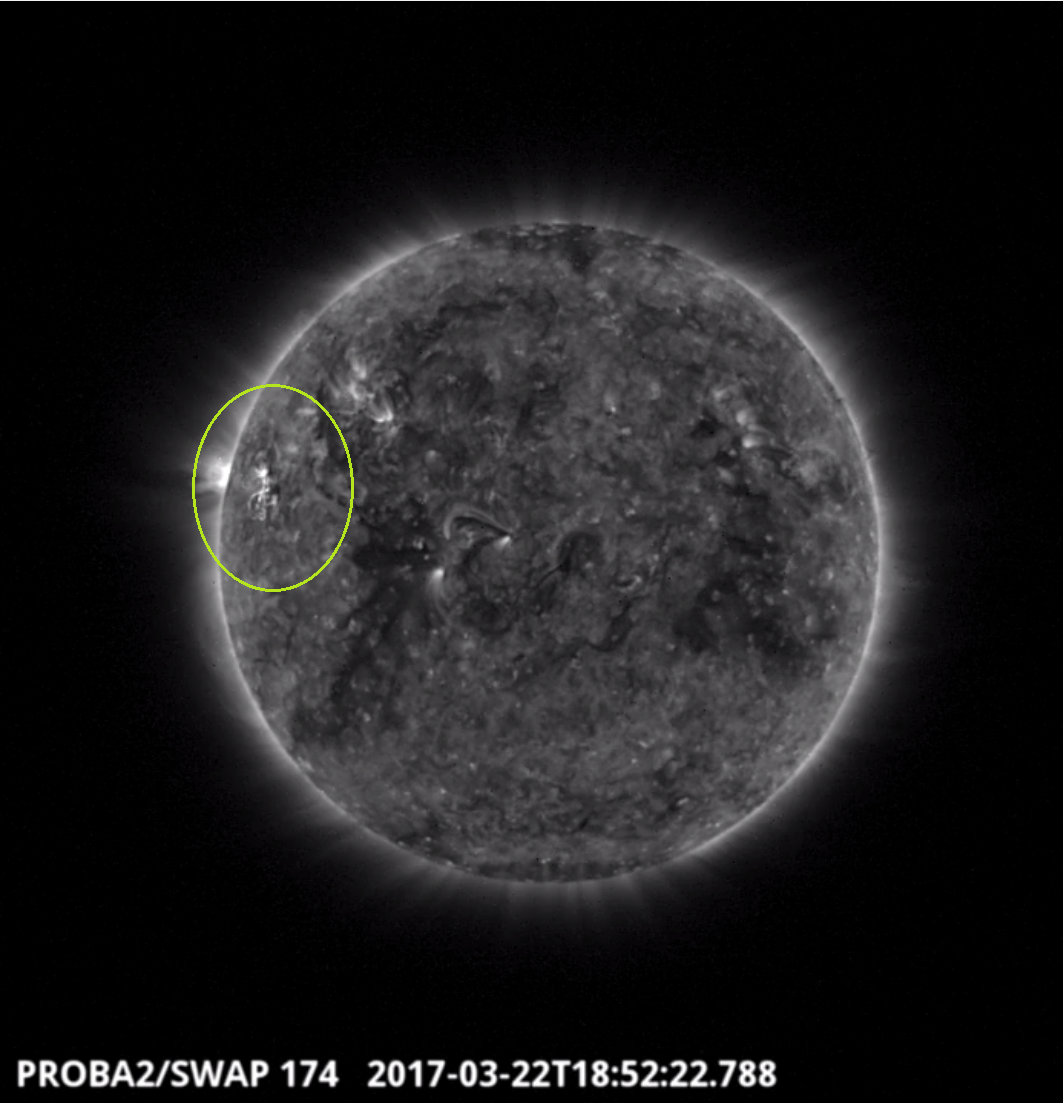
An eruption was observed by SWAP in the north-east quadrant of the Sun on 2017-Mar-22 shown here at 18:52 UT.
Find a movie of the event here (SWAP movie): http://proba2.oma.be/swap/data/mpg/movies/20170322_swap_movie.mp4
Sunday Mar 26
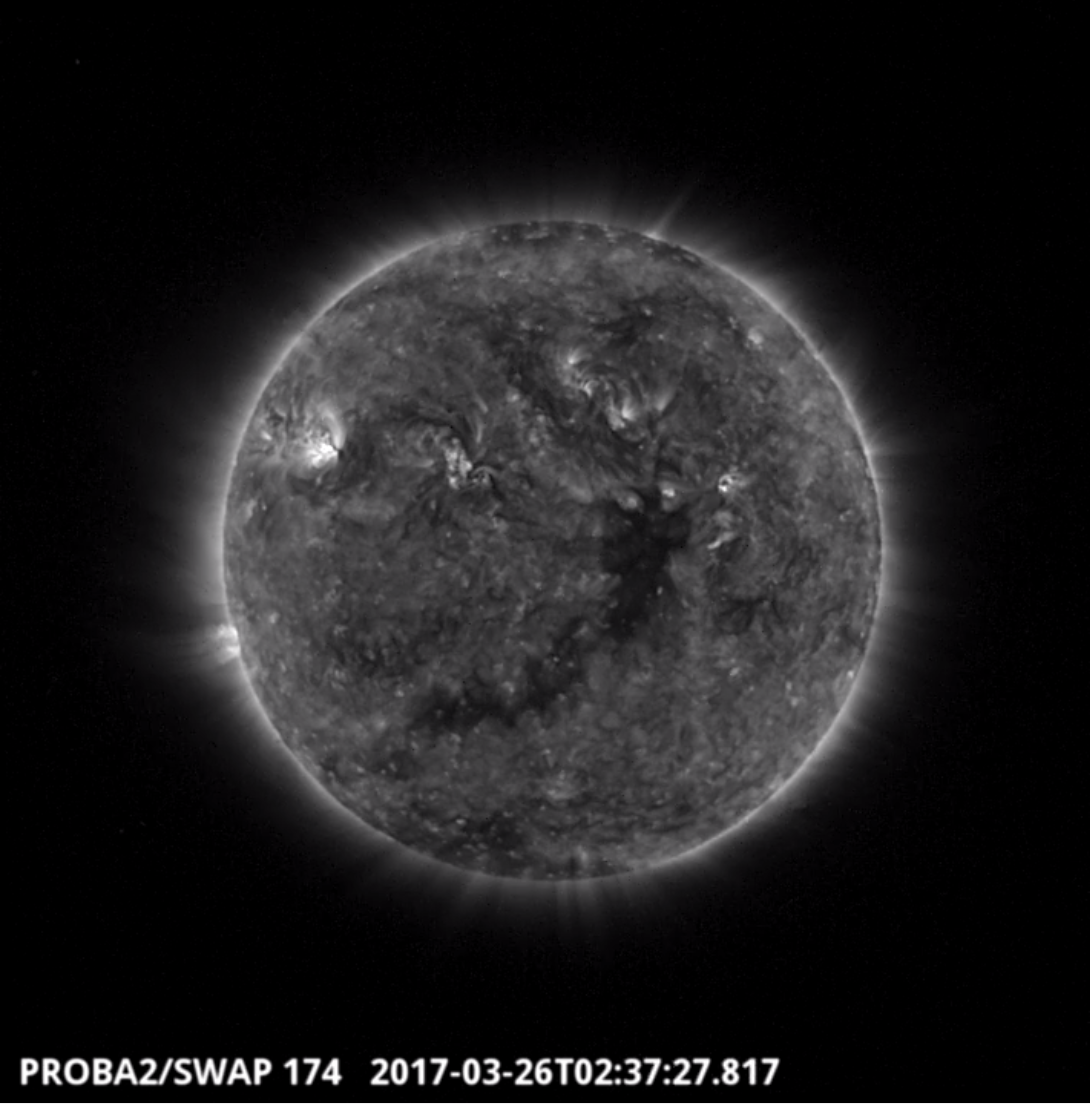
The largest flare (B4.0 class) of the week which was produced by AR 2644 was observed by SWAP on 2017-Mar-26, shown here in the eastern hemisphere of the Sun at 02:37 UT.
Find a movie of the events here (SWAP movie):
http://proba2.oma.be/swap/data/mpg/movies/20170326_swap_movie.mp4
Review of solar activity
SOLAR ACTIVITY
The GOES X-ray background was below B1 level throughout the week. The only regions were NOAA AR 2643 (alpha) and 2644 (beta), which produced only a few low B flares.

A weak filament eruption in the NE quadrant was observed in GONG H alpha and AIA HeII images around 17h UT on March 22. CACTUS, an automated CME detection program, detected an associated, narrow CME around 18:36 UT that day. The CME was not geoeffective.
GEOMAGNETIC ACTIVITY
A high speed stream from a positive coronal hole arrived at Earth in the first half of March 21. In the days after, the solar wind speeded up to about 750 km/s. DSCOVR registered a magnitude of the Interplanetary Magnetic Field (IMF) of maximum 18 nT on March 21. The z-component of the IMF fluctuated strongly around 0 nT during these days.
Accordingly, 3 intervals with minor geomagnetic storm conditions (K Dourbes = 5) were registered on March 21 and 22.
Solar wind speed started decreasing again to nominal levels on March 24.
The complete space weather briefing presented on Monday March 27

The International Sunspot Number
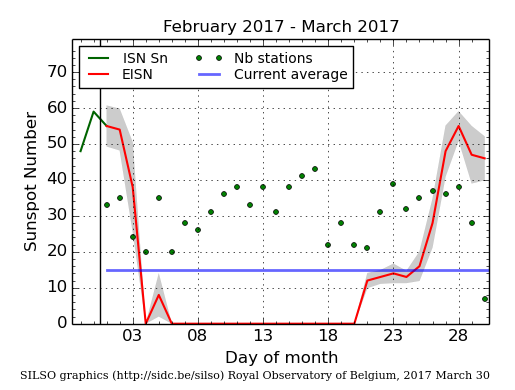
The daily Estimated International Sunspot Number (EISN, red curve with shaded error) derived by a simplified method from real-time data from the worldwide SILSO network. It extends the official Sunspot Number from the full processing of the preceding month (green line). The plot shows the last 30 days (about one solar rotation). The horizontal blue line shows the current monthly average, while the green dots give the number of stations included in the calculation of the EISN for each day.
Review of ionospheric activity (20 Mar 2017 - 26 Mar 2017)
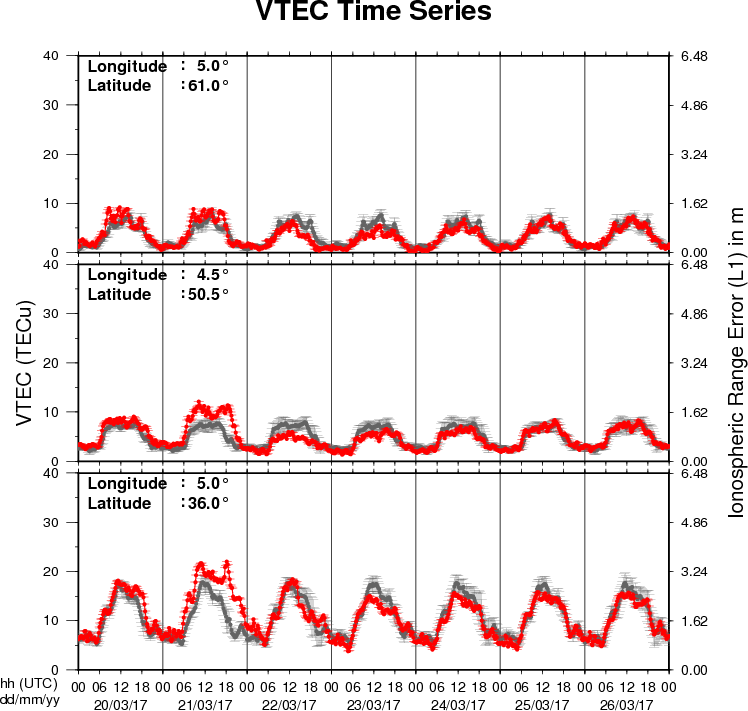
The figure shows the time evolution of the Vertical Total Electron Content (VTEC) (in red) during the last week at three locations:
a) in the northern part of Europe(N61°, 5°E)
b) above Brussels(N50.5°, 4.5°E)
c) in the southern part of Europe(N36°, 5°E)
This figure also shows (in grey) the normal ionospheric behaviour expected based on the median VTEC from the 15 previous days.
The VTEC is expressed in TECu (with TECu=10^16 electrons per square meter) and is directly related to the signal propagation delay due to the ionosphere (in figure: delay on GPS L1 frequency).
The Sun's radiation ionizes the Earth's upper atmosphere, the ionosphere, located from about 60km to 1000km above the Earth's surface.The ionization process in the ionosphere produces ions and free electrons. These electrons perturb the propagation of the GNSS (Global Navigation Satellite System) signals by inducing a so-called ionospheric delay.
See http://stce.be/newsletter/GNSS_final.pdf for some more explanations ; for detailed information, see http://gnss.be/ionosphere_tutorial.php
Future Events
For more details, see http://www.spaceweather.eu/en/event/future
International CCMC-LWS Workshop in Cape Canaveral, Florida (USA)
Start : 2017-04-03 - End : 2017-04-07
The goal of this working meeting is to address the need to
quantify and to track progress over time in the field of space
weather and to establish internationally recognized metrics that
are meaningful to end-users and developers. Defining a set of
appropriate metrics is important to track advancements in space
weather understanding and predictive capabilities.
This meeting is a part of the unfolding activities of the
International Forum for Space Weather Capabilities Assessment that
brings together space environment experts, model and application
developers, data providers, forecasters and end-users. The goals of
this community-wide forum include addressing challenges in
model-data comparisons and evaluating the current state of space
environment predictive capabilities. Workshop attendance is
encouraged but is not a requirement for joining forum teams.
Website:
http://ccmc.gsfc.nasa.gov/CCMC-LWS_Meeting/
Solar Orbiter Workshop 7: Exploring the solar environs in Granada, Spain
Start : 2017-04-03 - End : 2017-04-06
This event will be hosted by the Instituto de Astrofisica de
Andalucia - CSIC. Please mind that on April 7th the 20th SWT
meeting will take place at the same venue.
Website: Unkown
URSI General Assembly in Montreal, Canada
Start : 2017-08-19 - End : 2017-08-26
For the thirty-second time since the inception of URSI, Radio
Scientists from across the world will get together for the URSI
General Assembly and Scientific Symposium. This triennial gathering
will take place from 19th to 26th of August 2017, in Montreal,
Canada. This conference is a unique opportunity to learn about
recent advances in all fields of Radio Science, as covered by all
ten URSI Commissions.
Among the different sessions, please note:
* 'Radio Science for Space Weather'
Conveners: M. Messerotti, V. Pierrard
* 'Remote Sensing and Modeling of the Earth's Plasmasphere
and Plasmapause'
Conveners: A. M. Jorgensen, V. Pierrard, B. Heilig
The abstract deadline is 30 January 2017
Website: http://www.ursi2017.org
2017 Joint IAPSO-IAMAS-IAGA Assembly in Cape Town, South Africa
Start : 2017-08-27 - End : 2017-09-01
The Joint IAPSO-IAMAS-IAGA Assembly, endorsed by the University
of Cape Town and the South African Department of Science and
Technology, will take place from 27 August to 1 September 2017 at
the Cape Town International Convention Centre (CTICC). Several IAGA
and IAMAS sessions are of Space Weather interests as well as the
joint session 'Space Weather throughout the Solar System: Bringing
Data and Models together'.
Website:
http://iapso-iamas-iaga2017.com/index.php
Workshops on Radiation Monitoring for the International Space Station in Torino, Italy
Start : 2017-09-05 - End : 2017-09-07
The Workshop on Radiation Monitoring for the International Space
Station is an annual meeting to discuss the scientific definition
of an adequate radiation monitoring package and its use by the
scientific community on the ISS. Types of instruments and research
topics need to be defined in order to optimise the radiation safety
of the ISS crew.
Website: http://wrmiss.org/
European Space Weather Week 14
Start : 2017-11-27 - End : 2017-12-01
The ESWW is the main annual event in the European Space Weather
calendar. It is the European forum for Space Weather as proven by
the high attendance to the past editions. The agenda will be
composed of plenary/parallel sessions, working meetings and
dedicated events for service end-users. The ESWW will again adopt
the central aim of bringing together the diverse groups in Europe
working on different aspects of Space Weather.
Website:
http://www.stce.be/esww14/
